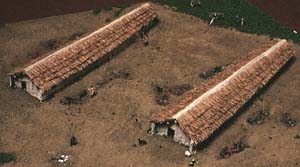- Home
- Time and place
- From The Neolithic to The Chalcolithic in Europe
Deposit of polished stone axes discovered at Arzon (Morbihan), Cliché Musée des Antiquités Nationales, Saint-Germain-en-Laye (Loïc Hamon).
This change in the modes of sustenance within human societies, during the Holocene (the post-glacier period), is used to define the term "neolithization", more so than, a culture's transition from nomadic life to settlements, or the invention of pottery.
At several places across the globe, in cultures independent of one another, humanity made a change from hunter-gatherer to agriculture and the domestication of animals, which diminished our long dependence on the places where we evolved.
The neolithization of Europe had gradually been followed by important socio-economic changes. From the very beginning of agriculture, animal husbandry, and the decrease in itinerancy, populations regrouped to form towns and villages.
The constant technical progress (progressive diversification and specialization of activities) permitted an increase in productivity, which, likewise, created demographic growth. The indomitable, rise and development of these societies brought about the advent of the use of copper metallurgy ; hence the term "chalcolithic" is applied to these civilizations.
In fact, "chalcolithisation" is defined, above all, by a social differentiation, more and more distinct, made visible by the appearance of rich tombs and objects of prestige, the appearance of temples and sanctuaries.
Model of danubian dwellings discovered at Loiret.


